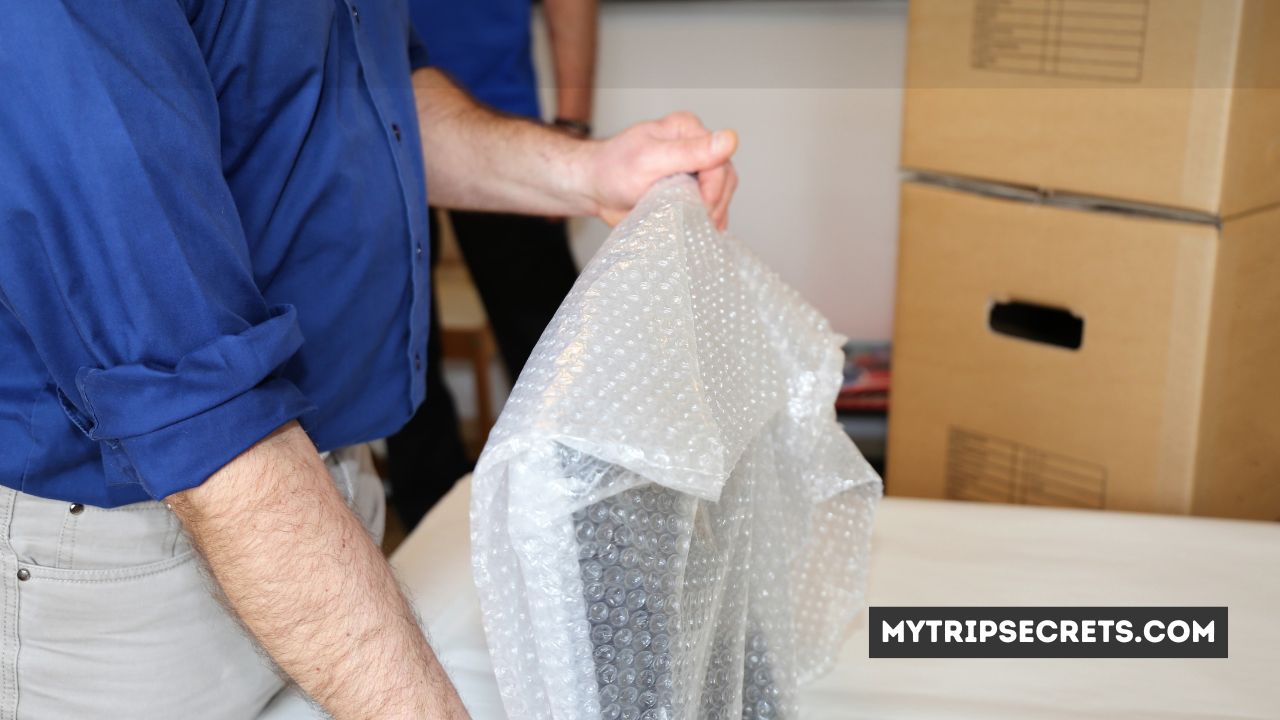Carrying a portable monitor enables individuals such as digital nomads, gamers, and creative workers to be productive and enjoy entertainment while travelling. Monitors, being costly and fragile gear, necessitate careful handling and extra attention when being transported. Inadequate packaging of a monitor may result in the occurrence of cracked screens, impaired pixels, damaged casings, fractured mounting brackets, and other financially burdensome issues. Given the frequent maltreatment of luggage by airlines and transport firms, it is essential to ensure correct packaging in order to maintain the faultless operation of your display.
By following the tips outlined in this guide, you can perfectly cushion, pad, and box up your monitor to arrive safely at any destination ready to use. We’ll provide packing strategies for all monitor sizes, detail exactly which protective materials to utilize, and explain how to best secure your monitor inside luggage.
Contents
Evaluate Monitor Size and Features
The monitor’s physical attributes play a key role in the best packing method to use. Assess these factors before starting:
Monitor Types & Size
Laptop displays fold into the computer body for easy mobility. But full-sized desktop monitors require more forethought to move safely. touching. Standard monitors have a separate power cable and video input. All-in-one models like Apple’s iMac integrate the computer into the display. Dimensions and weight determine available packing options. Measure your display screen and overall width, height and depth when closed. Large monitors won’t fit carry-ons requiring checked luggage.
Screen Type
Modern flatscreen LCD and LED monitors are slimmer and lighter than old bulky CRT models. However, all screens still require delicate handling to avoid damage.
Choosing Packing Materials
You need specific supplies to properly secure monitors during travel based on their size and type:
Hard Shell Monitor Case
Watertight hard-sided monitor cases offer the best protection with padded interior cushions or foam inserts that prevent movement. Available in various sizes for compact or widescreen displays.
Original Manufacturer’s Box
The custom cardboard box the monitor originally came in has pre-sized padding to keep it immobilized. Check sides for punctures or weaknesses.
Third Party Shipping Boxes
Oversize boxes allow room for extra packing material around the monitor. Look for double-walled cardboard rated for 30+ pounds.
Bubble Wrap/Packing Foam
Use liberal amounts of small bubble wrap sheets or foam pads to wrap the screen and other fragile areas. Avoid packing peanuts which shift during handling.
Preparing The Monitor for Transport
Before packaging up your monitor, take a few simple preparatory steps to get it travel ready:
- Keep upright at all times
- Never stack other objects on top
- Avoid extreme hot or cold
- Do not place near hazards like fuels, chemicals or food
- Clearly label with “fragile” warnings
- Inform handlers of high-value equipment
Disconnect Cables and Accessories
Remove all exterior cables, cords, and accessories attached to your monitor. This includes power cables, HDMI/DisplayPort/USB-C video connectors, headphone jacks, external webcams, calibration tools, etc. Reattaching cables is easy upon arrival, but loose accessories could damage the screen if left attached during transit.
Adjust Screen Position
Ideally, the screen should face inward toward the middle of the packing box or luggage. This keeps the fragile display panel protected behind extra layers of cushioning. If your monitor features height, pivot, tilt, or swivel adjustments, position the screen centrally without angling it up, down or sideways.
Inspect for Damage
Before packing up your monitor, carefully inspect it for any existing chips, cracks, dead pixels, or other external flaws. Photograph any minor imperfections should they worsen during shipping. This provides evidence when submitting damage claims to airlines or insurance providers.
Choosing Appropriate Shipping Boxes
The external shipping box is the first critical line of defense for keeping your monitor safe. To properly cushion and secure a monitor, choose a box that meets the following requirements:
Sized for Monitor Dimensions
The box must be sized to the exact dimensions of your monitor, allowing 2-3 inches of buffer space on all sides. Avoid overly large boxes which allow the monitor to shift and bounce unsecured inside. For irregular shaped ultrawides and curved displays, use the screen width/height as sizing measurements.
Durable Thick Corrugated Cardboard
Only use original manufacturer’s boxes made out of rigid 3/16 inch thick corrugated cardboard with double walled sides. If unavailable, purchase replacement boxes meant specifically to ship monitors and televisions. Never attempt to ship a monitor in thin single walled boxes.
Integral Internal Supports
High quality monitor boxes include die-cut cardboard partitions, frames, braces and supports to grip the screen in place and prevent internal movement. Cutting your own custom inner supports can damage the box’s structural integrity.
Packing Materials and Interior Cushioning
Filling empty spaces inside the shipping box with cushioning materials restricts monitor movement during handling and absorbs damaging impacts:
Expandable Foam
Expanding polyurethane foam sheets or bags that inflate to completely fill the empty spaces inside a box make excellent shock absorbing internal padding. The foam molds perfectly to irregular monitor shapes and prevents any shifting.
Air Pillows
For more standard rectangular monitors, use large 4”-6” thick inflated air pillows or bubble wrap to line all sides of the screen. Popcorn styrofoam loses cushioning capacity over time as pieces break apart.
Anti-Static Packaging
Utilize antistatic plastic bags or sheets during packing to prevent static discharge damages to monitor circuits and sensitive electronics. Many monitors come packaged in antistatic bags from manufacturers.
Cushion Monitor Vulnerabilities
Regardless of transport method, pay special attention to cushioning these extra-sensitive areas:
| Screen Surface | Wrap display two or three times with small bubble wrap to prevent scratches or cracks in glass/plastic. Avoid direct pressure. |
| Monitor Corners | Extra padding on all corners prevents dents if the monitor is bumped or dropped. |
| Vents/Ports | Cover airflow vents and input ports with foam pads to stop dust debris from damaging delicate internal electronics. |
The Right Way To Pack a Monitor for Travel

Follow these detailed steps for securing any size monitor in preparation for travel:
Prepare Bottom Monitor Cushioning
- Place expanding foam, air pillows, or bubble wrapped sheets across the entire bottom of the box. Cushioning should reach 2-3 inches up all sides.
- If included with the original box, set the custom molded monitor frame down into the bottom cushioning layer to hold the weight.
Lower Monitor Inside Box
- Gently place your monitor screen down into the box, resting on the padded monitor frame and cushions. Avoid dropping your monitor into the box.
- The screen should sit face down on the cushions.
Fill Side Cushioning
- Pack additional expanding foam bags, air pillows or bubble wrap along the monitor’s left and right sides. The cushions should fit snugly to prevent side-to-side shifting.
Top Cushions and Final Protection
- Finish by packing foam or cushions above and below the monitor to immobilize vertical movement. The entire monitor body should now feel completely immobilized.
- For added drop protection, seal the monitor inside an antistatic bag before closing up the box.
Tape Securely
- Seal the shipping box using 2-3” durable vinyl shipping tape. Completely wrap tape around all box edges and seams for reinforcement.
Internal Case Padding and Mounting Monitors
For travel cases and backpacks with customizable interior padding, monitor mounting likewise requires filling all empty spaces with dense protective materials:
Case Inserts and Foam Layers
Surround monitors inside hard or soft travel cases with 1-2” padding like closed cell foam inserts, padded dividers, and Pick N’ Pluck cubed foam layers. The case interior should prevent shifting.
Mounting Brackets
If checking a monitor mounted inside a flight or equipment case, ensure mounting brackets feature shock absorbing gel guards and secondary safety straps/fasteners. Never trust simple friction fittings alone.
Detachable Screens
Some custom travel cases allow detaching the monitor for separate transport inside protective wrap. This prevents transmitted case vibrations reaching the fragile screen.
Frequently Asked Questions
Can I pack my monitor in a suitcase for air travel?
Monitors under 24” can be wrapped in clothing inside luggage for cushioning. Larger monitors are safest transported in their original boxes. Improper packing risks cracking the screen.
What’s the safest way to transport a monitor by car?
The least risky method is packing the monitor in its manufacturer box, kept upright with seatbelts securing it inside the vehicle. Never place unsecured monitors on seats or in cargo areas.
How should I carry a monitor through the airport?
When transporting monitors as airline carry-on luggage, use a padded monitor messenger bag, laptop sleeve case or custom padded backpack with internal monitor mounts. Never check unboxed monitors.
Can I leave my monitor attached to a laptop inside luggage?
Never pack monitors while still attached devices like laptops—the weight of transit shocks and vibration risks damaging the ports. Always disconnect and separately cushion both products.
Is it safe to ship an ultrawide curved gaming monitor?
Ultrawide monitors require oversized custom boxes with inserted struts supporting the curved form. Use maximum expandable foam padding to prevent the delicate curved screen cracking in transit.
How to travel with a 27 inch monitor on a plane?
Taking a 27-inch monitor on an aeroplane in its original box with expanding foam cushions on all sides is the safest option. Secure the monitor in an antistatic bag first. Consider size constraints while bringing the boxed monitor on the plane as extra carry-on luggage. Since carry-ons stay in the cabin, you can prevent mishandling. Air travel with big monitors is possible with proper packing. Be careful and the monitor won’t come damaged.
What are airline policies for checking monitors?
No airlines formally guarantee checked monitor safety. However, most carriers cover monitors as standard lost luggage up to $3,500 when packed professionally in accordance with guidelines like this article outlines.
What’s the best way to transport a monitor for a LAN party?
Place smaller monitors snugly on the floor or back seat, cushioned by pillows and blankets to avoid sliding. Anchor larger models laying flat in a cargo area surrounded by soft items.
Is bringing my own monitor on vacation worth the hassle?
For digital nomads and gamers, having your specialized personal display may be essential, so it’s worth the effort to properly pack and transport it.
Conclusion
Packing monitors for transport entails certain hazards; however, by utilising suitable containers, snug interior cushioning, immobilising support structures, and handling precautions, it is possible to ensure that your display reaches its destination undamaged. Shock-absorbing materials that envelop monitors in their entirety prevent any empty spaces that could facilitate movement within the container while it is being shipped or transported. By adhering to these packaging best practices when preparing monitors for journeys, individuals who are constantly on the move for business, pleasure, or other interests can continue to appreciate their displays, including digital nomads, photographers, and gamers.
More Helpful Article That Might Help You
25 Tips for Enjoying Solo Travel
An Expert Guide To Solo Travel in Europe
20 Tips On How To Convince Parents For Solo Travel

